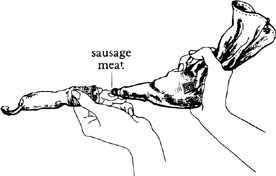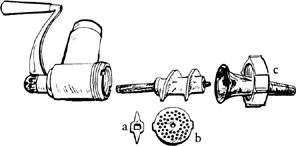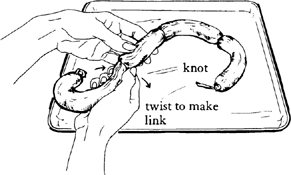Mastering the Art of French Cooking, Volume 2 (122 page)
Read Mastering the Art of French Cooking, Volume 2 Online
Authors: Julia Child

With the casing in place, you are now ready to stuff it. Have in mind how long you want your sausages to be, how many, if any, you want linked together, and if they are to be linked, whether the meat mixture is soft enough so that you can safely twist the filled casing into lengths without bursting it. This is mostly a matter of trial and error; if you want no errors and have plenty of casing, fill and either link or cut and tie one sausage at a time. To minimize air spaces and bubbles, watch casing carefully as you are filling it; when air spaces develop, push filled casing against end of horn to force air back into stuffer. In severe instances, when you are making linked sausages, you will have to cut the casing, tie it, and start a new series of links.
A pastry bag works surprisingly well for either stiff or soft sausage mixtures. |
|
| This oversize hypodermic consists of wooden plunger, cylinder, and detachable horn. |
For stiffer blends, you have to brace the end of the tube against the edge of a table. A pastry bag is easier in this case.
| A stuffing horn of plastic or metal 4 inches long, ¾ |
Sometimes the grinder is operated with cutting knife
(
a
)
and disk
(
b
)
as well as horn
(
c
), and sometimes not; if you have no instructions, you will have to try both ways. Some meat grinders work fairly well as sausage stuffers; others are maddeningly unsatisfactory.
Operate meat grinder at slow speed if it is electric, and hold casing horizontal with horn as meat goes in; |
|
| Tie a knot in the casing close against the meat at each end. |






